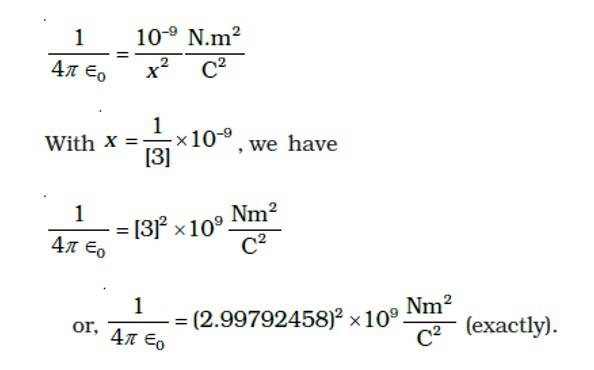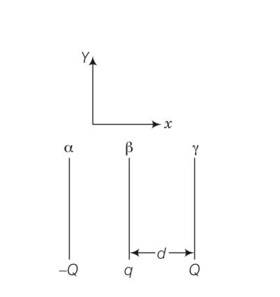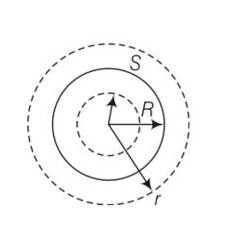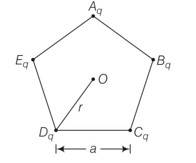Physics Ncert Solutions Class 12th
Get insights from 1.2k questions on Physics Ncert Solutions Class 12th, answered by students, alumni, and experts. You may also ask and answer any question you like about Physics Ncert Solutions Class 12th
Follow Ask QuestionQuestions
Discussions
Active Users
Followers
New answer posted
4 months agoContributor-Level 10
This is a Long Answer Type Questions as classified in NCERT Exemplar
Explanation- as we know F= Qq/r2= 1dyne = 1esu of charge2/1cm2
1 esu of charge = M1/2L3/2T—1
- Q=xC where x is dimensionless quantity
So F= =1 dyne = 10-5N
Taking x= 1/3 9
After solving we get 1/4
New answer posted
4 months agoContributor-Level 10
This is a Long Answer Type Questions as classified in NCERT Exemplar
Explanation- net electric field at plate γ due to two other plate
From plate 1 ,E1=
From plate 2 ,E2=
Total electric field E= E1 + E2 = to the left , if Q>q
electric field at o due to plate α =
electric field at o due to plate β =
electric field at o due to plate γ =
as the electric field at o is zero therefore
As there is no loss of charge on collision
Q+q=
On solving these
q1= (Q+q/2)= charge on plate β
q2= (q/2)= charge on plate γ
New answer posted
4 months agoContributor-Level 10
This is a Long Answer Type Questions as classified in NCERT Exemplar
Explanation-
(i) when r
= and we know that V =
= 4
=
E(4 ) = = so it is clear that E is radially outwards.
When r>R
=
E= again field is outwards
(ii) When two protons are there then they must be on opposite sides or we can say along the end of diameter
So q=
.q= 4
If protons 1 and 2 are embedded at distance r from the center of the sphere then force will be
F=eE=- but the force applied by proton F=
By adding these F= -
If F=0 then &nbs
New answer posted
4 months agoContributor-Level 10
This is a Long Answer Type Questions as classified in NCERT Exemplar
Explanation- let us consider that universe is of radius R
And we know that hydrogen is made up one electron and proton so net charge is
-(1+y)e+e = -ye
Now the number of hydrogen atom in the universe = N
So total charge is = -ye N
&n
New answer posted
4 months agoContributor-Level 10
This is a Long Answer Type Questions as classified in NCERT Exemplar
Explanation- (a)
(i) The electric field at the center of pentagon is zero because the distance from the center is same.
(ii) The field through one charge is Kq/r2
(iii) When one charge is positive and other is negative then net force towards negative charge. So net force is Kq/r2+ Kq/r2= 2Kq/r2
(b) It doesn't depend upon the number of sides increasing the net electric field is zero.
New question posted
4 months agoNew answer posted
5 months agoContributor-Level 10
9.32 Focal length of the convex lens, = 30 cm
The liquid acts as a mirror, focal length of the liquid =
Focal length of the system (convex lens + liquid), = 45 cm
For a pair of optical systems placed in contact, the equivalent focal length is given as
= + or = -
- 90 cm
Let the refractive index of the lens be and the radius of curvature of one surface be R
Hence, the radius of curvature of the other surface is –R
R can be obtained by using the relation
= ( + ) = (1.5 – 1)(
= , so R =
New answer posted
5 months agoContributor-Level 10
9.31 Angle of deflection, = 3.5
Distance of the screen from the mirror, D = 1.5 m
The reflected rays get deflected by an amount twice the angle of deflection, i.e. 2
The displacement (d) of the reflected spot of light on the screen is given as:
=
d = 1.5 tan 7 = 0.184 m = 18.4 cm
Hence, the deflection of the reflected spot of light is 18.4 cm.
New answer posted
5 months agoContributor-Level 10
9.30 Distance between the objective mirror and the secondary mirror, d = 20 mm
Radius of curvature of objective mirror, = 220 mm
Hence focal length of the objective mirror, = = 110 mm
Radius of curvature of secondary mirror, = 140 mm
Hence focal length of the objective mirror, = = 70 mm
The image of an object placed at infinity, formed by the objective mirror, will act as a virtual object for the secondary mirror. Hence, the virtual object distance for the secondary mirror,
u = = 110 – 20 = 90 mm
Applying the mirror formula for the secondary mirror, we can cal
New answer posted
5 months agoContributor-Level 10
9.29 Focal length of the objective lens, = 140 cm
Focal length of the eyepiece, = 5 cm
Least distance of distinct vision, d = 25 cm
In normal adjustment, the separation between the objective lens and the eyepiece
=
Height of the tower
Distance of the tower (object) from the telescope, u = 3 km = 3000 m
The angle subtended by the tower at the telescope is given as : = = rad
The angle subtended by the image produced by the objective lens is given as , where = height of the image of the tower formed by the objective lens
So, = = &nbs
Taking an Exam? Selecting a College?
Get authentic answers from experts, students and alumni that you won't find anywhere else
Sign Up on ShikshaOn Shiksha, get access to
- 65k Colleges
- 1.2k Exams
- 686k Reviews
- 1800k Answers







